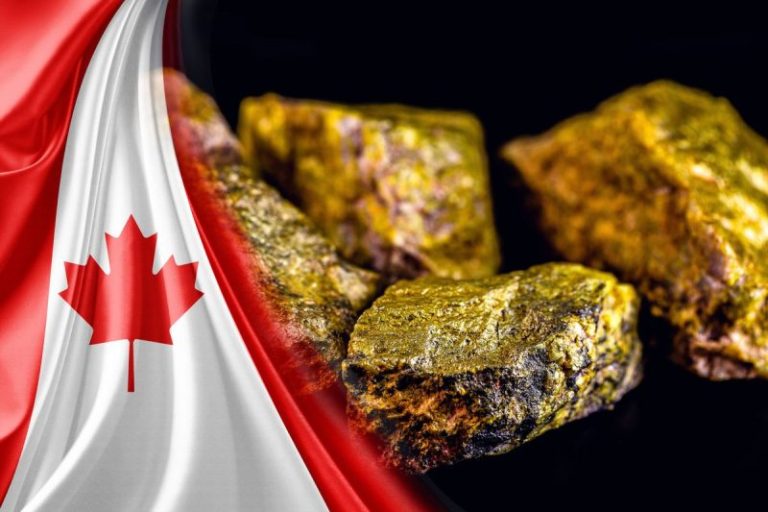The uranium market is entering the final quarter of 2025 with renewed momentum after a volatile year marked by tightening supply, bullish investor sentiment and lingering structural challenges.
Spot U3O8 prices have surged from a March low of US$63.25 per pound to a year-to-date high of US$83.18 at the end of September, driven by declining secondary supply and a resurgence of speculative capital. Yet, production setbacks from major suppliers like Cameco (TSX:CCO,NYSE:CCJ) and Kazatomprom underscore the sector’s fragile fundamentals.
Analysts warn that new mine development is lagging just as global demand is set to more than double by 2040.
The World Nuclear Association now projects it could take up to 20 years to bring new uranium capacity online — a growing concern as the US Energy Information Administration forecasts a cumulative shortfall of 184 million pounds without additional projects.
Against this backdrop, uranium equities have reemerged as a focal point for investors betting on a sustained nuclear renaissance. We profile the five best-performing Canadian uranium stocks by share price performance below.
All data was obtained on October 24, 2025, using TradingView’s stock screener. Uranium companies on the TSX, TSXV and CSE with market caps above C$10 million at that time were considered. Read on to learn about the top Canadian uranium stocks in 2025, including what factors have been moving their share prices.
1. Energy Fuels (TSX:EFR)
Year-to-date gain: 297.47 percent
Market cap: C$6.9 billion
Share price: C$29.89
US-based uranium producer Energy Fuels has a large portfolio of conventional and in-situ recovery (ISR) projects across the Western US, including Pinyon Plain in Arizona, a top national producer.
Additionally, Energy Fuels owns and operates the White Mesa mill, the only fully licensed and operating conventional uranium mill in the US. The company is progressing heavy rare earth oxide processing at the plant as well.
In line with US efforts to bolster domestic uranium output, Energy Fuels has been ramping up Pinyon Plain.
On August 6, Energy Fuels reported a productive second quarter, marking key progress across its US uranium operations. In Q2, the company produced 180,000 pounds of finished U3O8 at its White Mesa Mill in Utah and mined approximately 665,000 pounds of uranium ore from its Pinyon Plain and La Sal mines, with Pinyon Plain continuing to deliver some of the highest grades in US history.
Energy Fuels sold 50,000 pounds or uranium at US$77 per pound amid softer quarterly prices, citing expectations of stronger markets later in 2025. The company plans a major processing campaign in Q4 that will bring total production to roughly 1 million pounds of finished U3O8 in 2025.
The company revised its 2025 uranium sales guidance to 350,000 pounds — up from 220,000 — driven by stronger utility demand under long-term contracts.
By year-end, Energy Fuels expects to hold between 1.98 million and 2.58 million pounds of uranium in inventory, sufficient to meet its delivery commitments in 2026 and much of 2027.
Company shares reached a year-to-date high of C$36.84 on October 14, 11 days after Energy Fuels closed its US$700 million offering of 0.75 percent convertible senior notes due 2031, which was upsized after initial purchasers exercised their option to purchase a further US$100 million in notes.
2. District Metals (TSXV:DMX)
Year-to-date gains: 248.15 percent
Market cap: C$234.99 million
Share price: C$1.41
District Metals is an energy metals and polymetallic explorer and developer with a portfolio of seven assets in Sweden, including four uranium projects: Viken, Ardnasvarre, Sågtjärn and Nianfors. Currently, District is focused on its Viken uranium-vanadium project, which it says hosts the world’s largest undeveloped uranium deposit.
The company’s share price began trending upwards in mid-May following news of a fully subscribed C$6 million private placement.
In June, the company commended Sweden’s Ministry of Climate and Enterprise for submitting a proposal to lift the country’s longstanding ban on uranium mining. The referral recommends allowing uranium extraction under the Minerals Act and permitting exploration and processing applications under set conditions.
District has spent much of 2025 performing surveys at its four uranium projects. In late June, District completed a helicopter-borne mobile magnetotellurics survey at its flagship Viken property.
Additionally, in July, District announced drone-based radiometric and magnetic surveys across its Ardnasvarre, Sågtjärn and Nianfors projects, which are largely covered by thin glacial overburden and have never been subject to detailed geophysical surveying.
Results from the surveys at the Sågtjärn and Nianfors properties, released in early September, led the company to apply for new licenses to expand the landholdings at both projects.
On September 24, the company released the results for its mobile magnetotellurics survey at Viken, which it said identified large-scale low resistivity anomalies both related to the Viken deposit and outside of it, meaning the property has the potential to host further deposits.
District Metals reported results for its fiscal year ended June 30 the following day. The company ended the fiscal year with C$9.74 million in cash and also announced Boliden Mineral’s withdrawal from their joint venture on the Tomtebo and Stollberg projects.
Shares of District rallied to a year-to-date high of C$1.53 on October 15, the day the company released the results of its radiometric and magnetic survey at the Ardnasvarre property, which identified “strong and large” anomalies associated with “uranium polymetallic occurrences.”
3. Stallion Uranium (TSXV:STUD)
Year-to-date gain: 186.67 percent
Market cap: C$53.87 million
Share price: C$0.43
Uranium junior Stallion Uranium holds a 2,870 square kilometer land package on the western side of the Athabasca Basin, in Saskatchewan, Canada, including a joint venture with Atha Energy (TSXV:SASK,OTCQB:SASKF) for the largest contiguous project in the region. The company’s primary focus is the Coyote target at the Moonlite project.
Stallion’s share price shot upward on July 8 after it announced a technology data acquisition agreement for Matchstick TI, an intelligent geological target identification platform with 77 percent accuracy. Stallion plans to use the technology to enhance its exploration efforts. On July 14, the company reported the results of a 3D inversion of ground gravity data over the Coyote target, which is part of its joint venture with Atha Energy.
‘The inversion modelling at Coyote has delineated a laterally extensive and coherent gravity low, spatially coincident with a structurally complex corridor exhibiting attributes characteristic of fertile uranium-bearing systems within the Athabasca Basin,” Stallion Uranium CEO Matthew Schwab said.
In early September Stallion Uranium closed the final tranche of its non-brokered private placement, raising a total of C$10.49 million. The financing included 22.3 million non-flow-through units and 30.1 million flow-through units, both priced at $0.20 per unit.
Stallion’s shares registered a year-to-date high of C$0.51 on September 16.
On November 1, Stallion plans to commence a high-resolution ground time domain electromagnetic survey on the Coyote target.
4. Purepoint Uranium (TSXV:PTU)
Year-to-date gain: 163.64 percent
Market cap: C$45.52 million
Share price: C$0.58
Exploration company Purepoint Uranium has an extensive uranium portfolio including six joint ventures and five wholly owned projects, all located in Saskatchewan’s Athabasca Basin.
In January, Purepoint announced it had strengthened its relationship with IsoEnergy (TSX:ISO,NYSEAMERICAN:ISOU) when the latter exercised its put option under the framework of a previously announced joint-venture agreement, transferring 10 percent of its stake to Purepoint in exchange for 4 million shares.
The now 50/50 joint venture will explore 10 uranium projects across 98,000 hectares in the Athabasca Basin, including the Dorado project.
As for Q3, the company closed the final tranche of a C$6 million private placement on September 5.
Later in the month, Purepoint released partial assay results from the Dorado project. Notably, one drill hole returned the most significant intervals to date, according to the company, with 2.1 meters at 1.6 percent U3O8, including 0.4 meters at 8.1 percent and 4.9 meters at 0.52 percent.
Purepoint ended September by launching its inaugural drill program at the Tabbernor project, located on the southeastern edge of the basin.
“The 1,500-metre program will test five drill targets distributed across two of the three high-priority areas defined within a 60-kilometre-long corridor of graphitic conductors,” the statement noted.
Shares of Purepoint registered a year-to-date high of C$0.80 on October 14, coinciding with upward momentum in uranium prices.
5. Uranium Royalty (TSX:URC)
Year-to-date gain: 77.74 percent
Market cap: C$757.73 million
Share price: C$5.67
Uranium Royalty is the only publicly traded company focused exclusively on uranium royalties and streaming. The company offers investors exposure to uranium prices through interests in royalties, streams, debt, equity and physical uranium holdings.
The company currently has exposure to more than two dozen uranium companies in Canada, the US, Spain and Namibia, ranging from early exploration to production.
In May, Uranium Royalty acquired a 2 percent gross overriding royalty on the Aberdeen uranium project in Nunavut, Canada, for C$1 million in cash. The Aberdeen project lies adjacent to Orano Canada’s Kiggavik deposit, one of the world’s largest undeveloped uranium resources. The deal will be funded from existing cash reserves.
Forum Energy Metals, which was acquired by Baselode Energy (TSXV:FIND) in Q3, retains the option to repurchase 0.5 percent of the royalty under certain conditions.
In late August, the company renewed its at-the-market equity program, allowing the company to distribute up to US$54 million worth of common shares. The shares will be sold at prevailing market prices through designated agents at the company’s discretion.
Shares of Uranium Royalty also benefited from uranium market positivity in mid-October, and reached a year-to-date high of C$6.64 on October 15.
FAQs for investing in uranium
What is uranium used for?
Uranium is primarily used for the production of nuclear energy, a form of clean energy created in nuclear power plants. In fact, 99 percent of uranium is used for this purpose. As of 2022, there were 439 active nuclear reactors, as per the International Atomic Energy Agency. In 2023, 9 percent of US power came from nuclear energy.
The commodity is also used in the defense industry as a component of nuclear weaponry, among other uses. However, there are safeguards in effect to keep this to a minimum. To create weapons-grade uranium, the material has to be enriched significantly — above 90 percent — to the point that to achieve just 5.6 kilograms of weapons-grade uranium, it would require 1 metric ton of uranium pre-enrichment.
Because of this necessity, uranium enrichment facilities are closely monitored under international agreements. Uranium used for nuclear power production only needs to be enriched to 5 percent; nuclear enrichment facilities need special licenses to enrich above that point for uses such as research at 20 percent enrichment.
The metal is also used in the medical field for applications such as transmission electron microscopy. Before uranium was discovered to be radioactive, it was used to impart a yellow color to ceramic glazes and glass.
Where is uranium found?
The country with the greatest uranium reserves by far is Australia — the island nation holds 28 percent of the world’s uranium reserves. Rounding out the top three are Kazakhstan with 15 percent and Canada with 9 percent.
Although Australia has the highest reserves, it holds uranium as a low priority and is only fourth overall for production. All its uranium output is exported, with none used for domestic nuclear energy production.
Kazakhstan is the world’s largest producer of the metal, with production of 21,227 metric tons in 2022. The country’s national uranium company, Kazatomprom, is the world’s largest producer.
Canada’s uranium reserves are found primarily in its Athabasca Basin, and the region is a top producer of the metal as well.
Why should I buy uranium stocks?
Investors should always do their own due diligence when looking at any commodity so that they can decide whether it fits into their investment plans. With that being said, many experts are convinced that uranium has entered into a significant bull market, meaning that uranium stocks could be a good buy.
A slew of factors have led to this bull market. Discourse has been building around the metal’s use as a source of clean energy, which is important for countries looking to reach climate goals, and interest in nuclear power to fuel artificial intelligence energy demand has increased significantly as well.
Nations are now prioritizing a mix of clean energies such as solar and wind energy alongside nuclear. Significantly, in August 2022, Japan announced it is looking into restarting its idled nuclear power plants and commissioning new ones.
Uranium prices are very important to uranium miners, and levels had not been high enough for production to be economic. However, prices have climbed significantly in recent years, and spiked from US$58 per pound in August 2023 to a high of US$106 per pound in February 2024.
Securities Disclosure: I, Georgia Williams, hold no direct investment interest in any company mentioned in this article.



